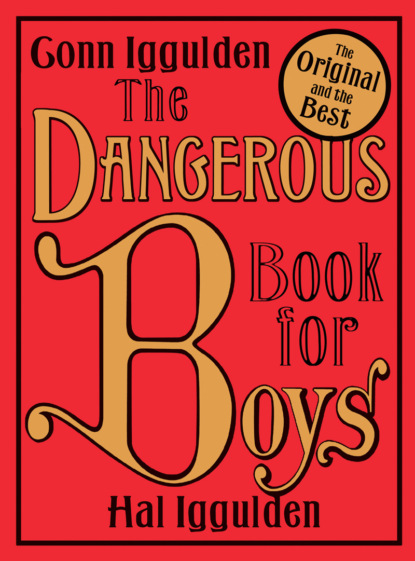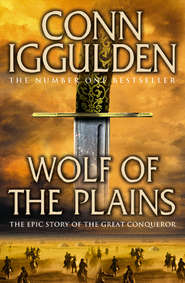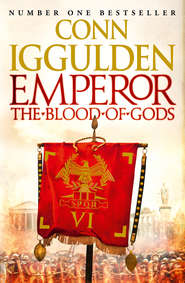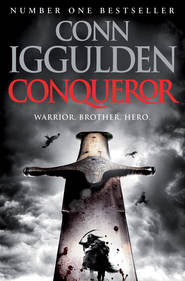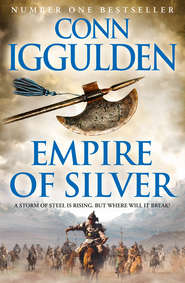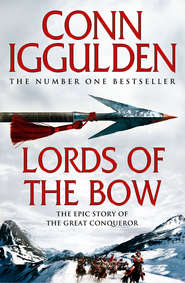По всем вопросам обращайтесь на: info@litportal.ru
(©) 2003-2024.
✖
The Dangerous Book for Boys
Настройки чтения
Размер шрифта
Высота строк
Поля
You’ll need very strong, thin string – we found nylon to be the best. Fishing line snapped too easily. Traditional bowstrings were made from waxed linen or woven horse hair, forming miniature cables of immense strength. The Romans even used horsehair to form great springs for their war catapults!
The knot you’ll need is a good all-rounder, from tying up a canal boat to stringing a bow. Its advantage is that the actual knot isn’t tightened under pressure, so it can always be loosened when you need to move on. It is called ‘the round turn and two half-hitches’.
First wind your rope fully around the bow end, as shown. This is the ‘round turn’. Then pass the end under the bowstring and back through the loop – a half hitch. Pull tight. Finally, do another hitch in the same way: under the string, back through the loop and away. You should end up with a knot that doesn’t touch the bow wood but is very solid.
As a final note, it is a very good idea to wear a glove on the hand that holds the bow as you draw back the string. The arrow passes over it at speed and can take skin off. Also, we found it much easier to pull the string back if we had strips of leather wound around the second and third fingers. You can probably get a piece of leather from a furniture shop as a sample, or an upholsterer’s offcut bin. Alternatively, you could just wear another glove. It may interest you to know that the rude gesture of sticking two fingers up at someone came from the English archers at Agincourt. The French had said that they would cut off the arrow-pulling fingers of those men when they beat them. Instead, the French were defeated and the archers mocked them by showing off their fingers – still attached.
Archery can be a fascinating and highly skilful sport and this isn’t a bad way to start.
Understanding Grammar – Part One (#ulink_460e76dd-5d1b-59ce-9a6f-87d264a050a2)
IT’S STRANGE HOW SATISFYING it can be to know right from wrong. Grammar is all about rules and structure. It is always ‘between you and me’, for example. If you hear someone say ‘between you and I’, it isn’t a matter of opinion, they’re just wrong.
The grammar of English is more complex than can be contained here, but a skeleton of basics is well within our reach. You wouldn’t use a chisel without knowing how to hold it. In the same way, you really should know the sharp end from the blunt one in everything else you use – including your language. The English language is spoken by more people on earth than any other, after all.
The first thing to know is that there are only nine kinds of words. Nine.
1. Nouns are the names of things. There are three kinds. Proper nouns have capital letters e.g. ‘Newcastle’. Abstract nouns are the things that exist but you can’t touch: ‘courage’, ‘loyalty’, ‘cruelty’, ‘kindness’. Common nouns are the words for everything else: ‘chair’, ‘eyes’, ‘dog’, ‘car’ and so on.
2. Verbs are words for action or change: ‘to become’, ‘to wash’, ‘to dissect’, ‘to eat’ and so on. There are six parts to each verb, known as first person singular, second person singular, third person singular, first person plural, second person plural and third person plural.
Most verbs follow this simple pattern.
Irregular verbs like ‘to be’ and ‘to have’ are not as … well, not as regular. They must be learned.
Note that the second person ‘you’ is the same in the singular and plural. In older forms of English, you would have used ‘thou’ as second person singular. In modern English it makes no difference whether you are addressing one man or a thousand, you could still begin as follows: ‘You are responsible for your behaviour.’
3. Adverbs are the words that modify verbs, adjectives and other adverbs. They are important as there is a huge difference between ‘smiling nastily’ and ‘smiling cheerfully’. Clearly the verb is not enough on its own.
Most adverbs end in ‘–ly’, as with the examples above. If you say, ‘I’ll go to the shops tomorrow,’ however, ‘tomorrow’ is an adverb, because it adds detail to that verb ‘go’. Words like ‘soon’ and ‘often’ also fall into this category. As a group, these are sometimes known as ‘adverbs of time’.
As mentioned above, an adverb can also add detail to an adjective. ‘It is really big’ uses ‘really’ as an adverb. ‘It is very small’ uses ‘very’ as an adverb. He walked ‘extremely quietly’ uses ‘extremely’ as an adverb for an adverb! This is not rocket science. Take it slowly and learn it all bit by bit.
4. Adjectives are words that modify nouns. In ‘the enormous snake’, ‘enormous’ is the adjective. More than one can be used together, thus: ‘the small, green snake’. Note the comma between the two adjectives. Putting a comma between adjectives is correct.
As a general rule, adjectives come before the noun. However, as always with English, rules have many exceptions: ‘That snail is slimy!’, for example.
5. Pronouns are words that replace nouns in a sentence. It would sound clumsy to say ‘John looked in John’s pockets.’ Instead, we say ‘John looked in his pockets’. ‘His’ is a pronoun. Here are some examples: I, you, he, she, we, they – me, you, him, her, us, them – my, your, his, her, our, their.
‘One’ is also used in place of ‘people in general’, as in the following sentence: ‘One should always invest in reliable stocks.’ The informal form of this is ‘you’, but it does sometimes lead to confusion, which keeps this unusual use of ‘one’ alive. The Queen also uses the ‘we’ form in place of ‘I’ during formal announcements.
6. A conjunction is a word that joins parts of a sentence together. ‘I tied the knot and hoped for the best.’ Tying the knot is a separate action to hoping for the best, joined by the word ‘and’. Conjunctions can also join adjectives, ‘short and snappy’, or adverbs ‘slowly but surely’.
Examples: and, so, but, or, if, although, though, because, since, when, as, whilst, nor.
The general rule is: ‘A sentence does not begin with a conjunction.’ Yes, you will find examples where sentences do begin with a conjunction. Professional writers do break this rule, but you should know it to break it – and even then do it carefully.
The examples above are fairly straightforward. It does get a little trickier when a conjunction is used to introduce a subordinate clause. (Clauses are covered in Grammar Part Two (#litres_trial_promo).)
‘Although he was my only friend, I hated him.’ (Although)
‘As I’m here, I’ll have a drink.’ (As)
In these two examples, the sentences have been rearranged to change the emphasis. It would have been clearer, perhaps, to write, ‘I’ll have a drink as I’m here’, or ‘I hated him although he was my only friend.’ It’s easier to see ‘although’ and ‘as’ are being used as joining words in that way, but many sentences begin with a subordinate clause.
7. Articles are perhaps the easiest to remember: ‘a’, ‘an’ and ‘the’. That’s it.
‘A/an’ is the indefinite article. Used when an object is unknown. ‘A dog is in my garden.’ ‘An elephant is sitting on my father.’
‘The’ is the definite article. ‘The dog is in the garden’ can refer to a particular dog. ‘The elephant is sitting on my father’ can mean only one elephant – one we already know: a family pet, perhaps.
‘An’ is still sometimes used for words that begin with a clearly sounded ‘h’: ‘an historical battle’, ‘an horrendous evil’ and so on. It is seen as old-fashioned, though, and using ‘a’ is becoming more acceptable.
8. Prepositions are words that mark the position or relationship of one thing with respect to another. Examples: in, under, over, between, before, behind, through, above, for, with, at and from. ‘He fell from grace’ demonstrates ‘from’ as a preposition. Another example is ‘He lived before Caesar’, or ‘I stood with Caesar.’
The general rule for prepositions is: ‘Don’t end a sentence with a preposition.’
It is not correct to say ‘This is my son, who I am most pleased with.’ It should be ‘This is my son, with whom I am most pleased.’
9. This is another of the easier types. Interjections are simple sounds used to express an inward feeling such as sorrow, surprise, pain or anger. This can be a wide group, as almost anything can be said in this way. Obvious examples are: Oh! What? Hell! Eh? Goodness gracious!
Note the last one – interjections don’t have to be a single word. It could be a whole phrase like ‘By the Lord Harry!’ or a complex oath. They tend to stand on their own and often have exclamation marks following them.
That is all nine.
Bearing in mind that English has more words than any other language on earth, it is quite impressive that there are only nine kinds. The first part of grammar is to learn those nine well and be able to identify them in a sentence. If you have, you should be able to name each of the eight kinds of words used in the following sentence. If it helps, we didn’t use a conjunction.
‘No! I saw the old wolf biting viciously at his leg.’
(Answer: ‘No!’ – interjection, ‘I’ – pronoun, ‘saw’ – verb, ‘the’ – definite article, ‘old’ – adjective, ‘wolf’ – common noun, ‘biting’ – verb, ‘viciously’ – adverb, ‘at’ – preposition, ‘his’ – pronoun, ‘leg’ – common noun. Eight different types.)
Table Football (#ulink_d35d1bcb-eed2-51c7-96b4-7cc32f4c4abd)
THIS IS A SIMPLE GAME, but it does require some skill and practice. It used to keep us occupied during French lessons.
You will need
A flat, smooth surface – a school table, for example.
Three two-pence pieces are best.
1. Place the coins on the close edge of the table, as in the diagram. The first blow must be struck with the heel of the hand against the coin half over the edge. The three coins will separate. From then on, only the coin closest to the player can be touched.
2. The aim of the game is to pass the coins up the table by firing the closest through the two further up. If you don’t get the coin through, that’s the end of your go and your opponent begins again from his side of the table. Just one finger is usually used to flick the coins. They should always be in contact with the table, so a great deal of the skill is in judging the force as well as planning ahead.
3. After a few of these ‘passes’, the opposing goal comes into range. This is provided by the other player, as shown.
4. If the goal shot misses, the game is lost. If the shooting coin strikes one of the other two, the game is also lost.





